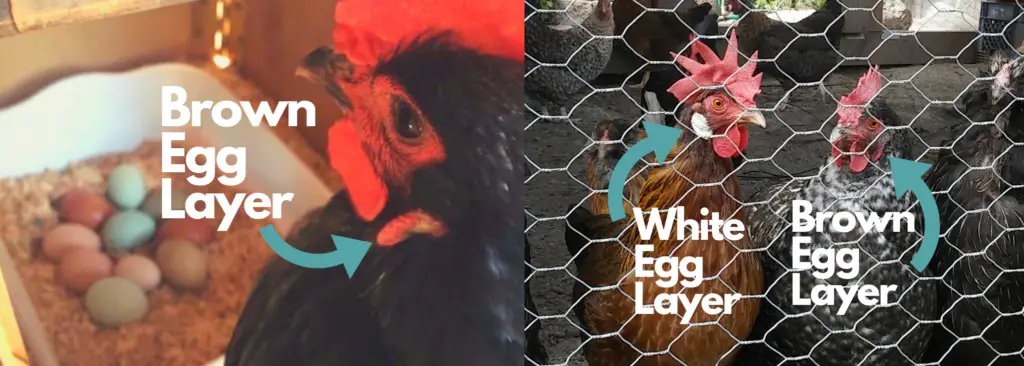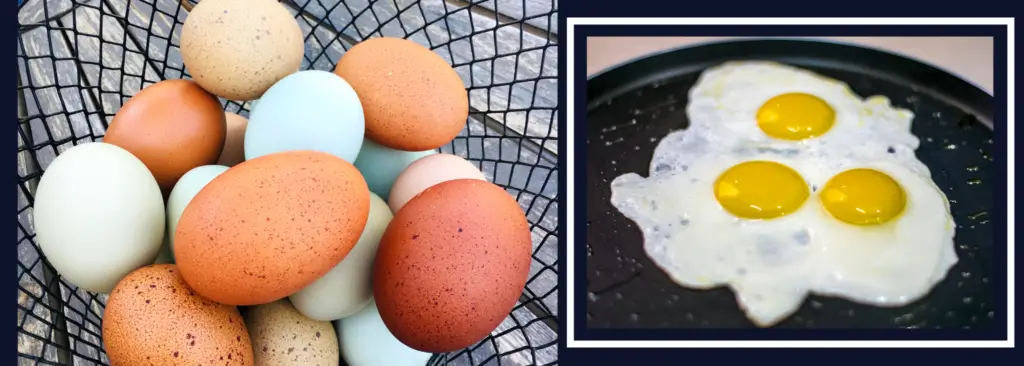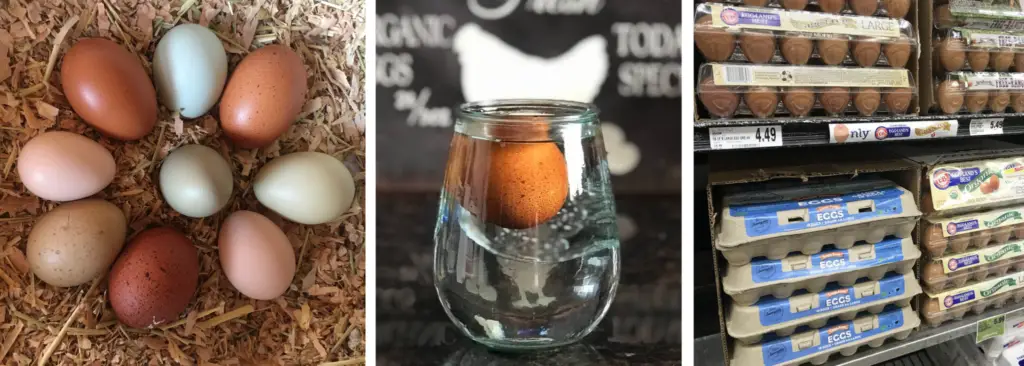
Egg color. Have you ever wondered why chicken eggs come in different colors or if one is nutritionally better than the other? They come in various shades of browns, greens and even blue’s! Here are some fascinating egg color facts you need to know!

Increases egg laying naturally.
- Improves chicken health.
- Deters parasites: mites, lice, fleas, flies & rodents.
- On SALE!
- SHOP NOW
1.Why are chicken eggs different colors?
All chicken eggs begin as white eggs. It’s the genetics of the hen that determine what color egg it will become. If an egg is any color other than pure white, pigment was deposited into it during the development.
There are 3 different pigments that determine what color egg a hen will lay, protoporphyrin, biliverdin, and biliverdin-zinc chelate.
Eggs come in a very wide variety of colors, ranging from white, cream colored, shades of pink, blue, brown and green.
Different breeds of chickens have varying levels of these pigments which results in a vast variety of egg colors!

An egg takes approximately 26 hours to develop and travel though a hens oviduct and about 20 hours of this is the development of the egg shell.
For more information on how an egg is formed, hour by hour, read my article The Fascinating 26 Hour Journey of a Chicken Egg.
Another fun egg color fact:
Chicken that lay brown eggs will always lay brown eggs, but at the beginning of the laying season may be a darker color brown and fade to a lighter brown toward the end of the laying season. This is because the hen produces more of the pigment in the beginning of the laying season!
One more fun egg color fact:
As hens age, their egg color lightens because they produce less pigment that gives the egg its color.
2. What kind of chicken lays colored eggs?
A hens genetics will determine what color egg it will lay. It’s genetics determine what type of pigment it produces. That’s why chicken eggs come in a myriad of colors: white, cream, browns, blues and greens.
Do Chicken’s Lay More Than 1 Color Egg?
A chicken that lays a blue egg will always lay a blue egg. It will never one day lay a brown or green egg. The only variance would be that the color may be more profound at the beginning of the laying season and lighten toward the end of the laying season.

An “Olive Egger” Chicken is the product of a cross between a brown egg laying breed and a blue egg laying breed. For example, a Black Copper Maran(dark brown gene) rooster and a Crested Cream Legbar (blue egg gene) will produce chicks that lay olive colored eggs and they are called Olive Eggers.
Egg Color by Breed
- Brown Leghorns lay white eggs.
- Crested Cream Legbars lay blue eggs.
- Easter Eggers lay various shades of blue, green and sometimes brown eggs.
- Black Copper Marans lay dark brown eggs.
- Olive Eggers lay various shades of green or olive colored eggs.
- Silkies lay small, cream colored eggs.
- Ameraucanas lay blue eggs.

For a list of the top 6 breeds that lay blue eggs, read my article, 6 Best Breeds that Will Lay Beautiful Blue Chicken Eggs.
Fun Egg Color Fact:
Sometimes, but not always, you can tell what color egg a hen will lay by the color of its earlobes. Most hens that have white earlobes will lay white eggs and most hens that have red earlobes will lay a brown egg. This is because the same gene that determines egg color also aids in determining earlobe color.
If you are looking for a colorful basket of eggs, read my article 5 Chicken Breeds Giving the Best Basket of Colorful Eggs to find out which 5 breeds to get.

3. Egg color. Do different colored eggs taste different?
Egg shell color has nothing to do with how an egg will taste. A brown egg that you buy from a supermarket is likely to taste just the same as a white egg that you buy there.
The only thing that can change the way an egg tastes is the diet of the hen and how fresh the egg is.
Many people wonder if different colored eggs will taste different. Especially if someone sees a blue or a green egg. The first question they ask is, “Does it taste different?
If you are looking to buy eggs from a supermarket look for eggs that say “pasture-raised.” This means that the chickens have been allowed to roam the pasture and have access to all kinds of bugs and greens, making their eggs richer and much tastier.
Find more information about eggs, including egg safety at the Egg Safety Center.
Be Aware:
Just because a carton of eggs says, “cage free” does not mean that the chickens have been allowed to roam the pastures. For many farmers, this just means that they have not been kept inside a cage. Many of these hens are kept indoors, within a barn, not having access to bugs, small animals and greens.

More Fun Egg Color Facts
1. A hen that is allowed to free range, eating a wide variety of bugs and greens from the land and garden, is more likely to have a richer colored yolk and creamier tasting egg!
2. An egg that goes straight from the coop to your plate is going to have a lot more flavor. Buy eggs from your local farmer, if you can!
3. Buying eggs at your local market? Eggs that you buy at the supermarket can be up to 2 months old by the time that you buy them!
4. By law, farmers are allowed to package eggs up to 30 days after they have been laid and supermarkets can sell the same eggs up to 30 days after the packaging date!
4. Is there any nutritional difference between white, brown, green and blue eggs?
There is no nutritional difference between white, brown, green and blue eggs. Egg color does not determine nutritional value of an egg, but the way in which the hen was raised does.
Free-ranging hens that are allowed access to daily sunshine, bugs and vegetation are going to lay eggs with increased nutritional value than store bought eggs.
Advantages to getting farm-fresh eggs:(other than egg color)
- Increased Omega-3 fatty acids
- Increased Vitamin D
- Decreased cholesterol
- Decreased saturated fat
- Increased Vitamin E
- Increased Vitamin A
- More Beta Carotene

Eggs laid by hens that are allowed to free-range in pastures have access to a healthier, more natural diet. Free-range and pasture-raised chickens get more exercise and are therefore healthier, producing better tasting eggs.
Chickens that are allowed to eat weeds, leafy greens and flowers is consuming more xanthophylls which is a natural yellow pigment. So, this is what gives a farm fresh egg yolk its deep, rich orange color!
5. Why are brown eggs more expensive?
Chickens that produce colored eggs burn more calories producing pigments on a daily basis. Therefore, they need more nutrients to support this. Because of the increased feed cost to farmers, colored eggs cost more.
Some people think the answer to this question is that brown eggs are more nutritious than white eggs and this is just not true. Egg color does NOT determine the nutritional value of an egg. The reason brown eggs are more expensive lies within the hen.
All eggs take the same journey within a hen, but eggs of color take an extra step along the way!
Colored Eggs Fun Facts:
Chickens breeds that release a pigment during the egg production process, produce a colored egg. Breeds that release a pigment called protoporphyrin produce brown eggs. Pigments called oocyanin produce blue eggs.

Oocyaninis, blue pigment, is released in the early stages of the egg journey resulting in both the inner and outer shell tinted blue. Crested Cream Legbars lay blue eggs.
Protoporphyrin, brown pigment, is released later in the journey of the egg in the oviduct. So only the outer shell is brown and the inner shell remains white.
Excretion of both blue and brown pigments results in a green egg being laid. Olive Eggers and Easter Eggers lay shades of green eggs.
Another Fun Fact about Egg Color:
Read my article on The Fascinating 26 Hour Journey of a Chicken Egg for a detailed explanation of how a chicken egg is formed and gets its color.
Conclusion
- A chickens genetics determines what color egg it will lay.
- It will lay the same color egg throughout its lifetime.
- All colored eggs have the same nutritional value.
- Only the way a hen was raised/fed can change the nutritional value.
- Colored eggs cost more because chickens that produce them burn more calories producing color pigments. Increased calories burned = increased feed = increased feed cost.
To find out what chickens will give you the most beautiful colorful basket of eggs, read my article 5 Chicken Breeds Giving the Best Basket of Colorful Eggs.






